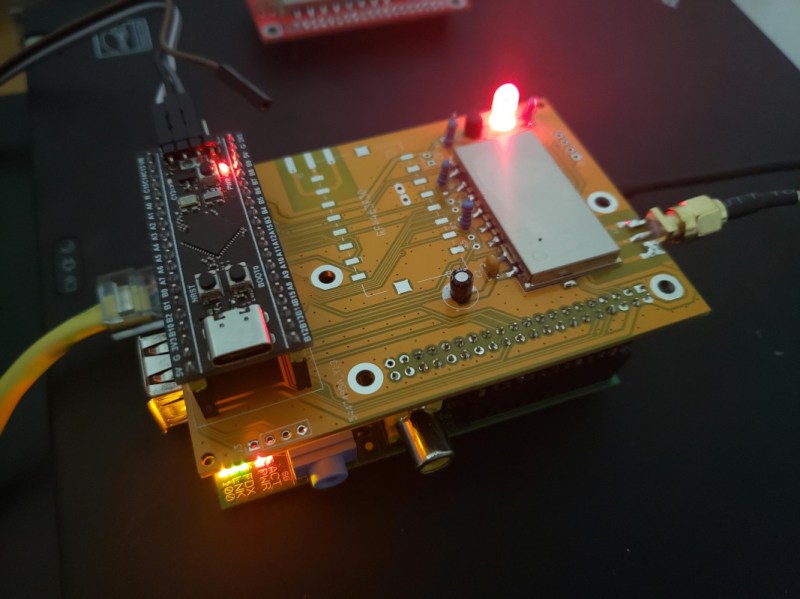Starlink has been making tremendous progress towards providing world-wide access to broadband Internet access, but there are a number of downsides to satellite-based internet such as the cluttering of low-Earth orbit, high expense, and moodiness of CEO. There are some alternatives if standard Internet access isn’t available, and one of the more ambitious is providing Internet access by balloon. Project Loon is perhaps the most famous of these (although now defunct), but it’s also possible to skip the middleman and build your own high-altitude balloon capable of connection speeds of 500 Kbps.
[Stephen] has been working on this project for a few months and while it doesn’t support a full Internet connection, the downlink on the high altitude balloon is fast enough to send high-resolution images in near-real-time. This is thanks to a Raspberry Pi Zero on board the balloon that is paired with an STM32 board which handles the radio communication on a RF4463 transceiver module. The STM32 acts as an intermediary or buffer to ensure reliable information is sent out on the radio, rather than using the Pi directly. [Stephen] also wrote a large chunk of the software responsible for handling all of these interactions, optimized for balloon flight specifically.
The blog post for this project was written a few weeks ago with a reported first launch date for the system already passed, so we will eagerly anticipate the results and the images he was able to gather using this system. Eventually [Stephen] hopes the downlink will be fast enough for video as well.Balloons are an underappreciated tool as well, and this isn’t the only way that they can be used to help send radio signals from place to place.

















More balloons for the air force to shot down?
Sure! 98 more are missing, still.
The website says the balloon will be launched 17 Jun 2023 but has yet to post any updates.
“Starlink has been making tremendous progress towards providing world-wide access to broadband Internet access, but there are a number of downsides to satellite-based internet such as the cluttering of low-Earth orbit, high expense, and moodiness of CEO.”
If this is your argument you’ve already failed.
This
This looks like a WOT
Wide Open Throttle?
Ukraine’s access was threatened.
That’s more about the case of starlink in particular – it’s established fact that Ukraine’s access was threatened and only maintained once more money was coughed up. Unfortunately having enough competitors to make the whims of a single provider be of little concern would be irresponsible, as we would really rather not clutter the skies with a wide variety of providers’ possibly poor attempts.
Yeah
Raytheon is being handed money hand over fist. But Musk is evil for wanting a little appreciation.
But that wasn’t really why I posted; this proposed idea isn’t the solution to a big problem, it’s a solution to a small problem. It’s a one off thing, interesting to those with interest in RF (including me), but it is in now way an alternative to such things as Starlink.
Interesting. RF4463 + STM32 could mean that it is also NPR-70 capable.
A NPR-70 IP Router in the sky on 70cm ham band would be quite the thing.
I’ve always found internet technology to be boring, though. Ham net is boring, as well. It’s just lame old internet, on a different frequency. By contrast, Packet-Radio radio (AX.25) used to be fascinating. It was different, an adventure. I was feeling like this since the 90s. I had dial-up internet, Netscape browser etc. But it was a boring experience compared to using DOS and “surfing the air waves” with Graphic Packet and finding new digipeater. Anyway, each to his/her/they own.
One of the fascinating aspects of “OPR” (Old Packet Radio) is independence.
By using AFSK, you can use about any medium to build an infrastructure. CB-Radio, shortwave, medium wave, VHF/UHF, infrared, laser, microwave link, sonic waves etc. Traditional Packet-Radio would even work under water. Or in space – Doppler effect and latency aren’t such a problem, because of being able to use FM and because AX.25 tolerates high latency. Speaking of, true Packet-Radio allowed using different modulation types (FSK signal gets embedded inside). By comparison, NPR is severely limited. But the sad thing is that people don’t realize what they had. They’re like children. Quicker! Farther! Higher! That’s what depressed me the most. Amateurs had such a wonderful Packet-Radio network. And what did they do? Let it rot. They gave it up in favor of cheap, short-lived internet technology. If amateurs were wise, the old Packet-Radio network could have been a common heritage for generations.